Let’s Take a Trip to the Skinniest House in New York
April 3, 2011
A couple weeks ago, we took a trip to Julianne Moore’s house in Greenwich Village, a section of New York City in Manhattan.
March 20, 2011: Let’s Take a Trip to Julianne Moore’s House
April 18, 2010: How to Live the Good Life in the Traditional City
The purpose was to get you used to the idea of living in a proper Traditional City urban house — the attached townhouse. In fact, this house is quite beautiful and has a luxurious big backyard.
It is on a land plot of about 2200 square feet, or 1/20th of an acre. This would be considered a very small plot indeed in Suburban Hell, but in the context of the Traditional City it is spacious, even extravagant.
This particular house is a good example of a Traditional City style urban design. However, Greenwich Village and New York City are not. They are examples of 19th Century Hypertrophism. So, I want you to think of the house, not the street and the city in general. Think of a house like Julianne Moore’s, but in a proper Traditional City environment like this:
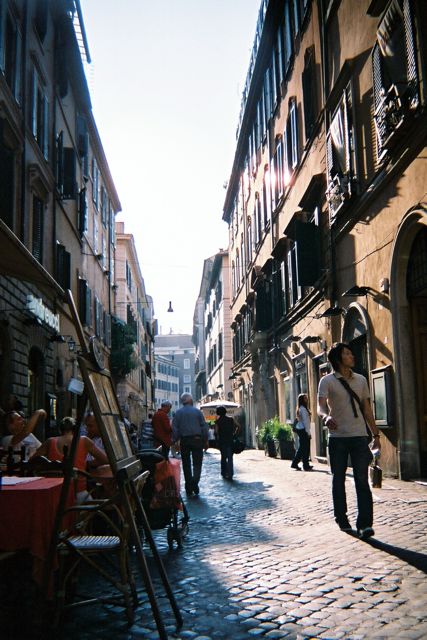
What’s the difference? Primarily it is the width of the street. This street is a proper pedestrian street, about 20 feet wide. That is actually on the wide side for a pedestrian street, which is why actually only half the street is being used for transit, and the other half for an outdoor cafe.
January 31, 2010: Let’s Take a Trip to New York 2: The Bad and the Ugly
January 24, 2010: Let’s Take a Trip to New York City
February 21, 2010: Toledo, Spain or Toledo, Ohio?
These photos describe very well the difference between a Traditional City Really Narrow Street and a typical 19th Century Hypertrophic Street.
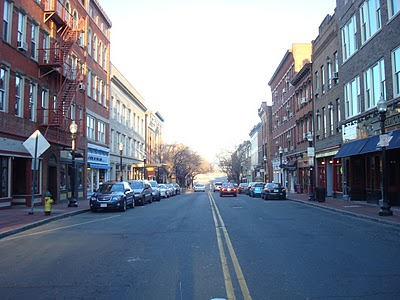
Washington Street, Norwalk, CT.
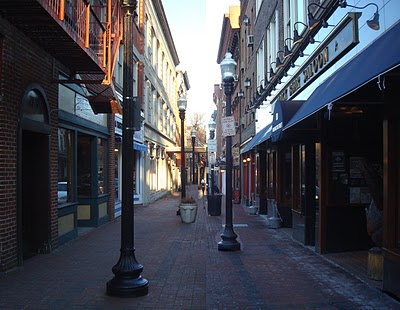
A typical Really Narrow Street.
Doesn’t that look like a nice place. No Cars!
Actually, it is the same street, with the center automobile roadway digitally removed. We just got rid of four lanes of auto traffic.
http://oldurbanist.blogspot.com/2011/03/thinking-small-narrow-streets-movement.html
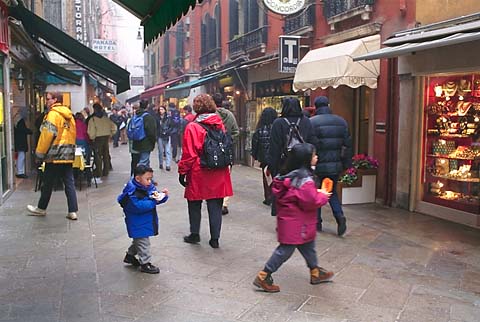
Typical commercial street in Venice, a city with no cars.
Looks about the same as our digitally-modified Norwalk street doesn’t it?
A Traditional City will have some larger “arterial” streets somewhat like Washington Street, with a central roadway, but that should be only a small fraction of overall streets. I think a ratio of about 80% Really Narrow Streets/17% Arterial Streets/3% Central Boulevards is good.
(A Central Boulevard would be something like Broadway in New York or the Champs Elysees in Paris.)
In that case, why not just use an example from France? Because people can’t relate. They say, “oh that is so quaint, and typical for a bunch of quiche-eating surrender monkeys.” I need to use examples of Americans living in these sorts of houses, and enjoying it. It helps us to cross the line from “oh, that’s a nice postcard shot from a European vacation,” to “hmmm, yes, that could be a viable solution for me.” (Remember I’m dealing with retards here.)
As it turns out, Greenwich Village also has the narrowest house in New York City. The land it stands on is nine and a half feet wide, and thirty-two feet deep. That is 304 square feet.
Now let’s just think about that for a moment. An acre has 43,560 square feet. So we are talking about 1/143th of an acre. It is only one-seventh the size of the land that Julianne Moore’s house is on.
A hundred-and-forty-third of an acre? Is that possible? Is it tolerable?
Of course, you can have a lot higher density than that with an apartment building. You can easily do 300+ apartments per acre, with a Traditional City design of 5-6 stories like you see in the photo above, and no high-rises. But for now we will talk about single-family houses.
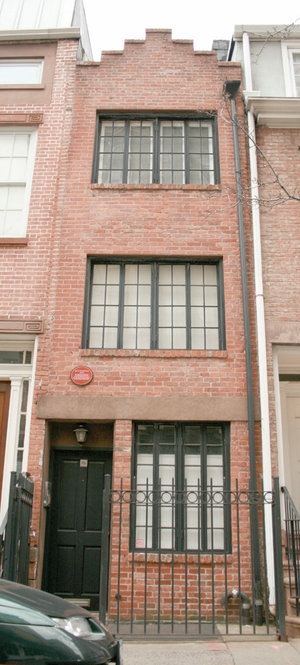
OK, it is obviously not as luxe as Julianne Moore’s place. However, you have to admit it looks perfectly comfortable.
We could be picky and list some design flaws — notably, the vestigal setback and “front yard” in the form of three feet of concrete surrounded by an iron railing. Is this really necessary? If you only have 304 square feet to work with, do you really want to blow 10% of it on a concrete setback that serves no purpose? This is why I say “buildings side by side, and up against the street.” However, remember that this is a 19th Century Hypertrophic City, not a Traditional City, so it is facing a street that is actually about the same size as Washington Street in Norwalk, above. This creates a psychological need for a “buffer” between the living areas and the inhospitable outdoor environment, and a subconscious urge to hide behind an iron fence with spikes on top. Normally, this would also be combined with an enormous stairway, another architectural “buffer,” but here the size of the house makes that somewhat inpractical.
With those quibbles aside: Could you live there? Would it be OK?
As it turns out, this tiny house has had quite a list of famous occupants since its construction perhaps in the 1850s.
Cartoonist William Steig lived there.
Anthropologist Margaret Mead lived there.
Writer Ann McGovern lived there.
Actors Cary Grant and John Barrymore are reported to have lived there.
Poet Edna St. Vincent Millay lived there.
Let’s compare the lifestyle of someone living here with someone living in a much larger brownstone in the same neighborhood. Is it only 1/7th as good? No, it is practically identical. There’s really no hardship involved in living in a place like this, or an apartment of similar size.
Indeed, there is a lot less hardship in some ways. It’s a heck of a lot cheaper. And a lot less bother to decorate and maintain.
September 20, 2009: The Problem of Scarcity 2: It’s All In Your Head
September 13, 2009: The Problem of Scarcity
Here are a few more skinny houses.
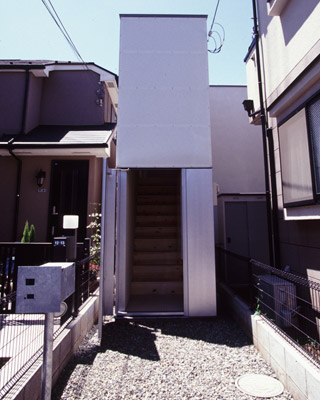
Tokyo.
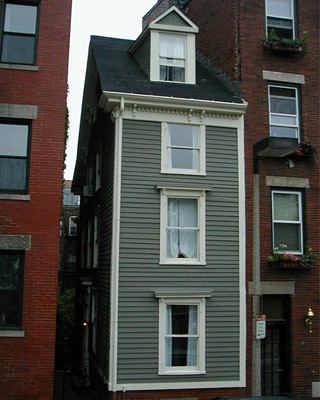
Boston
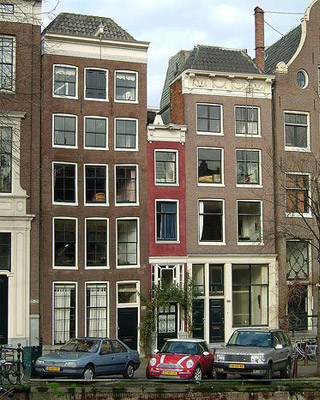
Amsterdam.
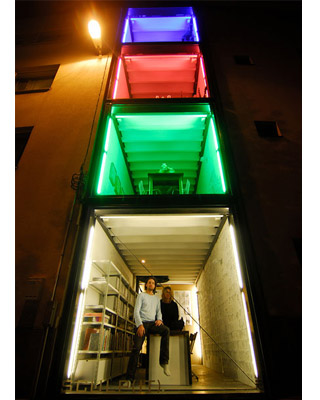
Antwerp.
The most important thing, however, is not the house itself, but, as any real estate broker will tell you, the location location location. Ideally, a house like this would be located in a beautiful Traditional City neighborhood. John O’Brien is an artist who has done some wonderful paintings of Traditional City environments. Try to think of what it would be like to live in this house, in a John O’Brien painting.
Visit John O’Brien’s website

Doesn’t look like Greenwich Village does it?
Or Queens? Or Chicago?
Queens, like almost all 19th Century Hypertrophic Cities, is basically a dump.
If you build a 19th Century Hypertrophic City, you will probably end up with a dump.
If you build a Traditional City, you will probably end up with something fabulous.
Choose wisely.
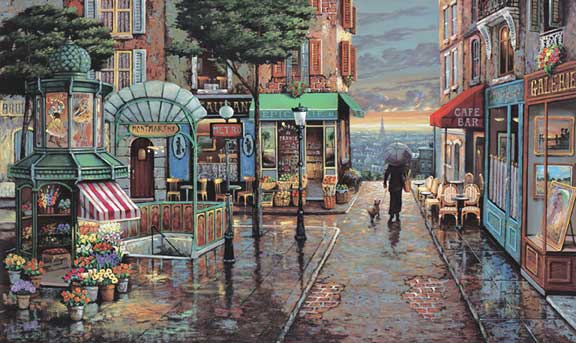
Look at the width of the street here. It is 10-15 feet. No cars. No green space. Just a guy and his dog walking down the middle of the street.
February 13, 2011: Let’s Take a Traditional City Break 2: More Really Narrow Streets Than You Can Shake a Stick At
February 6, 2011: Let’s Take a Traditional City Break
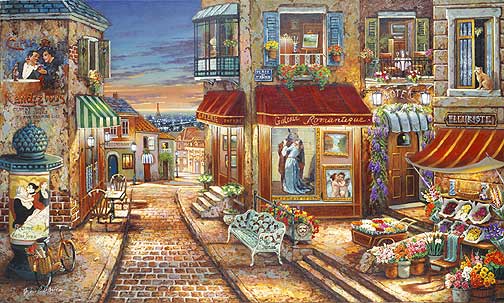
Lots of fun.
December 19, 2010: Life Without Cars: 2010 Edition
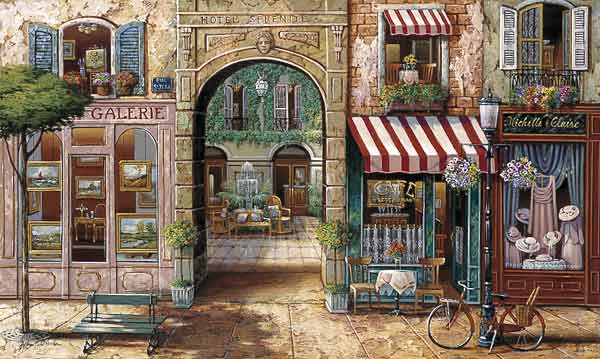
Look how every square inch is beautiful.
Nice example of an urban courtyard here too.
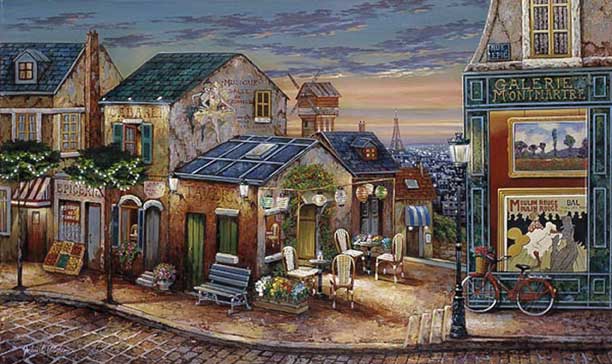
No Non-Place.
October 10, 2009: Place and Non-Place

Girls in dresses.
November 22, 2009: What Comes After Heroic Materialism?

How about making something like this your urban ideal? It is so easy to do.
Really Narrow Streets.
Buildings side by side and up against the street.
No cars.
By the way, all these pictures are based on real parts of France, mostly Paris.
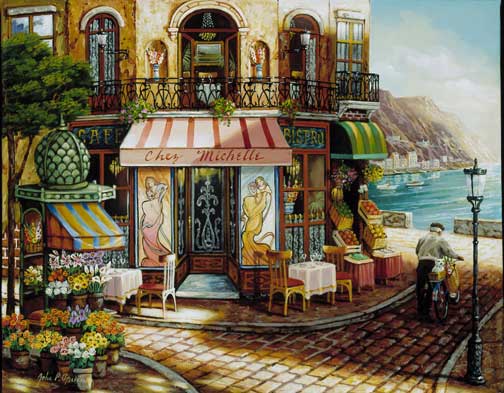
A city should be a place that children, women, and the elderly are comfortable in.
What if, say, San Diego looked like this?
Can you envision how fabulous it would be to have San Diego’s climate and beaches, combined with a city like this?
You could walk to the beach and go surfing in the morning and then have breakfast at Chez Michelle. How fabulous would that lifestyle be?
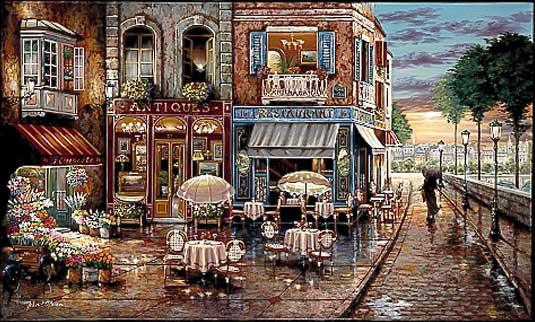
Not really griping about how small your house is anymore, are you?
Maybe you are starting to feel a bit of pity for those still wasting away in Suburban Hell.
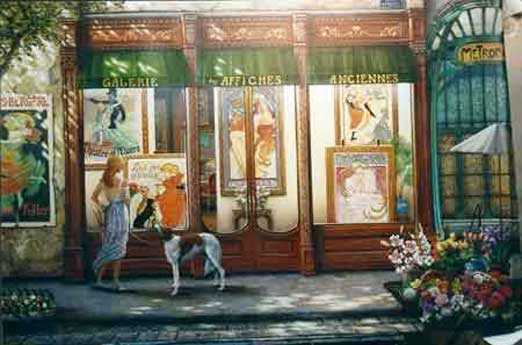
You should think of it in terms of lifestyle, not how-many-square-feet.
You can have a lot of square feet and a crappy lifestyle (McMansion/Suburban Hell)
You can have just a few square feet and a crappy lifestyle (trailer park/Suburban Hell)
Or,
You can have a lot of square feet and a wonderful lifestyle (huge townhouse/Traditional City)
You can have just a few square feet and a wonderful lifestyle (small apartment/Traditional City)
Other commentary in this series:
March 20, 2011: Let’s Take a Trip to Julianne Moore’s House
February 13, 2011: Let’s Take a Traditional City Break 2: More Really Narrow Streets Than You Can Shake a Stick At
February 6, 2011: Let’s Take a Traditional City Break
December 19, 2010: Life Without Cars: 2010 Edition
October 17, 2010: The Problem of Scarcity 3: Resource Scarcity
August 22, 2010: How to Make a Pile of Dough with the Traditional City
August 1, 2010: The Problem With Bicycles
June 6, 2010: Transitioning to the Traditional City 2: Pooh-poohing the Naysayers
May 23, 2010: Transitioning to the Traditional City
May 16, 2010: The Service Economy
April 18, 2010: How to Live the Good Life in the Traditional City
April 4, 2010: The Problem With Little Teeny Farms 2: How Many Acres Can Sustain a Family?
March 28, 2010: The Problem With Little Teeny Farms
March 14, 2010: The Traditional City: Bringing It All Together
March 7, 2010: Let’s Take a Trip to Suburban Hell
February 21, 2010: Toledo, Spain or Toledo, Ohio?
January 31, 2010: Let’s Take a Trip to New York 2: The Bad and the Ugly
January 24, 2010: Let’s Take a Trip to New York City
January 10, 2010: We Could All Be Wizards
December 27, 2009: What a Real Train System Looks Like
December 13, 2009: Life Without Cars: 2009 Edition
November 22, 2009: What Comes After Heroic Materialism?
November 15, 2009: Let’s Kick Around Carfree.com
November 8, 2009: The Future Stinks
October 18, 2009: Let’s Take Another Trip to Venice
October 10, 2009: Place and Non-Place
September 28, 2009: Let’s Take a Trip to Barcelona
September 20, 2009: The Problem of Scarcity 2: It’s All In Your Head
September 13, 2009: The Problem of Scarcity
July 26, 2009: Let’s Take a Trip to an American Village 3: How the Suburbs Came to Be
July 19, 2009: Let’s Take a Trip to an American Village 2: Downtown
July 12, 2009: Let’s Take a Trip to an American Village
May 3, 2009: A Bazillion Windmills
April 19, 2009: Let’s Kick Around the “Sustainability” Types
March 3, 2009: Let’s Visit Some More Villages
February 15, 2009: Let’s Take a Trip to the French Village
February 1, 2009: Let’s Take a Trip to the English Village
January 25, 2009: How to Buy Gold on the Comex (scroll down)
January 4, 2009: Currency Management for Little Countries (scroll down)
December 28, 2008: Currencies are Causes, not Effects (scroll down)
December 21, 2008: Life Without Cars
August 10, 2008: Visions of Future Cities
July 20, 2008: The Traditional City vs. the “Radiant City”
December 2, 2007: Let’s Take a Trip to Tokyo
October 7, 2007: Let’s Take a Trip to Venice
June 17, 2007: Recipe for Florence
July 9, 2007: No Growth Economics
March 26, 2006: The Eco-Metropolis

